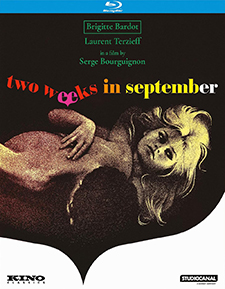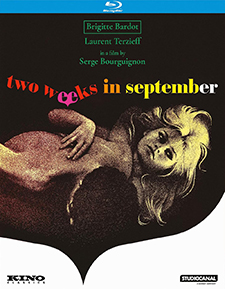Two Weeks in September (Blu-ray Review)

Director
Serge BourguignonRelease Date(s)
1967 (September 10, 2024)Studio(s)
Films du Quadrangle/Francos Films/Kenwood Films/Les Films Pomereu (Kino Classics)- Film/Program Grade: C+
- Video Grade: A
- Audio Grade: A
- Extras Grade: B
Review
Brigitte Bardot was making films as early as 1952 but it was as an immoral small-town teenager in 1956’s And God Created Woman, directed by Roger Vadim, that established her as an international star. Bardot went on to play various versions of her sex kitten alter-ego well into the early 70s. Two Weeks in September stars Bardot as a beautiful woman who has an affair that leads to emotional conflict.
French former fashion model Cecile (Bardot) is married to publisher Philippe (Jean Rochefort). They love each other but she has begun to feel restless and decides to go back to work. In London on an assignment, she enjoys the excitement of socializing with her fellow models and relishes the change from her stale married life. Out partying with her friends, she attracts the attention of handsome, vital Vincent (Laurent Terzieff) and does her best to suppress her interest in him. He nonetheless charms her and soon they find themselves enjoying passionate lovemaking. Now Cecile is torn between two men she loves in different ways.
As with most Bardot films, the plot revolves around a woman’s sexual awakening and there are teasing glimpses of nudity. This time, the script tends to be overly talky, the locations in Paris and London are minimally exploited, and there’s little backstory to explain why Cecile is impatient with her marriage. We don’t see much of the domestic life of Cecile and Philippe aside from an opening segment that shows Philippe, surrounded by piles of books and manuscripts, settled into comfortable routine while Cecile longs for something more.
Director Serge Bourguignon concentrates on the affair between Cecile and Vincent, which ranks as one of the most mundane and uninteresting on screen. Part of this is due to a lack of chemistry between the two actors. The best scenes occur when Cecile first arrives in London and goes out on the town with her model pals. She savors her modeling gig, the night life, independence, and especially the change from bored wife to vibrant woman-about-town.
As the film progresses, it becomes a deeper exploration of guilt, hard choices, and personal responsibility. Bardot handles these later scenes effectively as she tries to navigate her character’s inner turmoil, but she can’t save a picture that lacks spark. With the right material, she truly shines, but Two Weeks in September provides little of that.
Director of photography Edmond Sechan shot Two Weeks in September on 35 mm Eastmancolor film in the anamorphic Franscope process, finished photochemically, and presented in the aspect ratio of 2.35:1. The new 4K restoration, featuring a 2.39:1 aspect ratio, captures excellent grain quality. Clarity and contrast are both above average. The color palette is best appreciated in the model shoot sequences, when Bardot is adorned with multi-hued clothes in picturesque locations. Romantic scenes between Bardot and Terzieff are discreetly filmed, with shadows, editing, and lots of close-ups suggesting their characters’ passion.
The soundtrack is French 2.0 DTS-HD Master Audio. The film can be watched with or without English subtitles. Dialogue is clear and distinct. The club scenes blend music, ambient crowd noise and dialogue, all nicely mixed so that none of the dialogue is obscured. Michel Magne’s score is peppy and upbeat in early scenes and quiet and romantic in scenes between Cecile and Vincent.
Bonus materials on the Region A Blu-ray release from Kino Classics include the following:
- Audio Commentary by Adrian Martin
- Les Femmes (1969) Theatrical Trailer (1:59)
Audio Commentary – Film historian Adrian Martin notes that the French title—A Coeur Joie—translates to To Your Heart’s Content. He speaks about director Serge Bourguignon’s coming to prominence with the 1962 film Sundays and Cybele. The director is known for his obvious use of point-of-view shots. Sometimes disquieting, they enable the viewer to see how one character looks at another. Cecile does what she wants, whether dancing, watching fireworks, or talking to strangers. She’s a child-woman who needs to be protected and guided, who has the guilelessness of a child with a sense of fun. Her mouth even forms a childish pout. In telephone calls between Cecile and Philippe, the camera never cuts away to Phillipe, which defies typical movie narrative. Instead, the camera stays with Bardot, capturing her expressions. Bardot’s career turned “fallow” in the mid-1960s. Bardot’s personal life affected the roles she played in her later career. She was sick of playing voluptuous idiots and sought diverse roles. In Two Weeks in September, Bardot’s Cecile is torn between two very different options—security vs. mad love. It’s about an open relationship of free love, suggesting honesty rather than mere hedonism. The film is sparse in characters’ backstories but leaves open the possibilities of the future. In classic Bardot films, the viewer never really knows what will become of her character. The original title of the film was Prologue, since it marks the beginning of a new chapter in Cecile’s life. How can she move with the times while remaining the child/woman? There cannot be an answer, only a prologue.
The plot of Two Weeks in September isn’t particularly distinctive and the male characters are far less interesting than Bardot’s Cecile. For a romantic story, the film is pretty much a drawn-out slog. Still, it’s always interesting to watch Brigitte Bardot, and her star power may make the film worth a look. Beautiful and alluring, she convincingly conveys emotional conflict and vulnerability.
- Dennis Seuling

